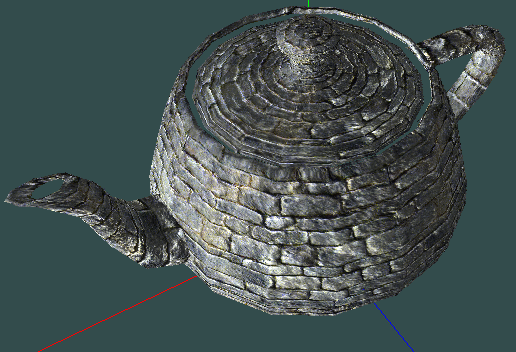软件光栅器实现(四、OBJ文件加载)
本节介绍软件光栅器的OBJ和MTL文件加载,转载请注明出处。
在管线的应用程序阶段,我们需要设置光栅器所渲染的模型数据。这些模型数据包括模型顶点的坐标、纹理、法线和材质等等,可以由我们手动编写,也可以通过文件读取。OBJ文件就是一种常用的存储模型数据的文件格式,它内部包含有所有渲染所需的信息。
比如:
mtllib myteapot.mtl 表示模型的材质文件名
v 7.0000 12.0000 -0.0000 顶点位置
vn 0.9667 -0.2557 0.0105 法线向量
vt 0.5000 1.9000 0.0000 纹理坐标
f 1/1/1 2/2/2 3/3/3 f开头的行,表示一个三角面的三个顶点信息索引值,比如1/1/1表示顶点索引1的点,法线信息取vn的第1个,纹理信息取vt的第1个。
在模型加载时调用相关方法,从设定的路径读取obj文件即可:
GeometryGenerator::GetInstance()->LoadOBJModel(m_box, "Models/myteapot.obj");
//从obj文件加载茶壶模型 Models/myteapot.obj Models/probeColor.obj
其中m_box为自定义的网格数据结构GeometryGenerator::MeshData* :
class GeometryGenerator
{
private:
GeometryGenerator() {} public:
static GeometryGenerator* GetInstance()//饿汉
{
static GeometryGenerator instance;
return &instance;
} //基本网络结构:顶点集合+索引集合
struct MeshData
{
std::vector<VertexIn> vertices;
std::vector<UINT> indices;
}; //创建一个立方体:指定宽(X方向)、高(Y方向)、深(Z方向)
void CreateBox(float width, float height, float depth, MeshData &mesh);
void LoadOBJModel(MeshData &mesh, char* filename);
};
LoadOBJModel()方法就是用于加载OBJ文件的核心方法:
void GeometryGenerator::LoadOBJModel(MeshData &mesh,char* filename){
//载入obj文件,获取顶点纹理法线数据
ObjParser* pObjParser = new ObjParser();
pObjParser->SetFileName(filename);//myteapot.obj probeColor
pObjParser->ReadFileCounts();//统计顶点纹理和法线数mVertexCount、mTexcoordCount等等
//将数据传入顶点、纹理、法线和面数组
// After get enough memory, clear these counts to 0, use it as index
VertexType* vertices = new VertexType[pObjParser->mVertexCount];
VertexType* texcoords = new VertexType[pObjParser->mTexcoordCount];
VertexType* normals = new VertexType[pObjParser->mNormalCount];
FaceType* faces = new FaceType[pObjParser->mFaceCount];
std::ifstream fin;
fin.open(pObjParser->mInFile);
if (fin.fail())
{
pObjParser->mErr << "Open input file : Failed." << std::endl;
return;
}
char input;
char ignore;
int iver = , itex = , inor = , ifac = ;
fin.get(input);
while (!fin.eof())
{
if (input == 'v')
{
fin.get(input);
switch (input)
{
case ' ':
{
fin >> vertices[iver].x >> vertices[iver].y >> vertices[iver].z;//写入顶点数组
//vertices[iver].z *= -1.0f; // RH->LH
iver++;
break;
}
case 't':
{
fin >> texcoords[itex].x >> texcoords[itex].y >>texcoords[itex].z;//写入纹理数组
//texcoords[itex].y = 1.0f - texcoords[itex].y; // RH->LH
itex++;
break;
}
case 'n':
{
fin >> normals[inor].x >> normals[inor].y >> normals[inor].z;//写入法线数组
//normals[inor].z *= -1.0f; // RH->LH
inor++;
break;
}
}
}
if (input == 'f')
{
fin.get(input);
if (input == ' ')
{//写入三角面的数组,换个旋转方向,要不然会被背面剔除
fin >> faces[ifac].vIndex1 >> ignore >> faces[ifac].tIndex1 >> ignore >> faces[ifac].nIndex1;
fin >> faces[ifac].vIndex2 >> ignore >> faces[ifac].tIndex2 >> ignore >> faces[ifac].nIndex2;
fin >> faces[ifac].vIndex3 >> ignore >> faces[ifac].tIndex3 >> ignore >> faces[ifac].nIndex3;
ifac++;
}
}
while (input != '\n')
fin.get(input);
fin.get(input);
}
fin.close();
//以上代码将数据读取到vertices、texcoords、normals和faces数组中
mesh.vertices.clear();
mesh.indices.clear();
mesh.vertices.resize(pObjParser->mFaceCount * );
//一共36个索引(每面6个)
mesh.indices.resize(pObjParser->mFaceCount * );
int i = , j = ;
for (; i < pObjParser->mFaceCount * ;){
mesh.indices[i] = i;
mesh.indices[i + ] = i + ;
mesh.indices[i + ] = i + ;
mesh.vertices[i].pos.x = vertices[faces[j].vIndex1 - ].x;//绑定顶点坐标
mesh.vertices[i].pos.y = vertices[faces[j].vIndex1 - ].y;
mesh.vertices[i].pos.z = vertices[faces[j].vIndex1 - ].z;
mesh.vertices[i].pos.w = ;
ZCVector tmp1 = mesh.vertices[i].pos;
mesh.vertices[i].tex.u = texcoords[faces[j].tIndex1 - ].x;//绑定纹理坐标
mesh.vertices[i].tex.v = texcoords[faces[j].tIndex1 - ].y;
mesh.vertices[i].normal.x = normals[faces[j].nIndex1 - ].x;//绑定法线
mesh.vertices[i].normal.y = normals[faces[j].nIndex1 - ].y;
mesh.vertices[i].normal.z = normals[faces[j].nIndex1 - ].z;
mesh.vertices[i].normal.w = ;
mesh.vertices[i].color = ZCVector(.f, .f, .f, .f);//绑定颜色
mesh.vertices[i].color = ZCVector(.f, .f, .f, .f);
mesh.vertices[i].color = ZCVector(.f, .f, .f, .f);
mesh.vertices[i + ].pos.x = vertices[faces[j].vIndex2 - ].x;
mesh.vertices[i + ].pos.y = vertices[faces[j].vIndex2 - ].y;
mesh.vertices[i + ].pos.z = vertices[faces[j].vIndex2 - ].z;
mesh.vertices[i + ].pos.w = ;
ZCVector tmp2 = mesh.vertices[i+].pos;
mesh.vertices[i + ].tex.u = texcoords[faces[j].tIndex2 - ].x;
mesh.vertices[i + ].tex.v = texcoords[faces[j].tIndex2 - ].y;
mesh.vertices[i + ].normal.x = normals[faces[j].nIndex2 - ].x;
mesh.vertices[i + ].normal.y = normals[faces[j].nIndex2 - ].y;
mesh.vertices[i + ].normal.z = normals[faces[j].nIndex2 - ].z;
mesh.vertices[i + ].normal.w = ;
mesh.vertices[i + ].color = ZCVector(.f, .f, .f, .f);
mesh.vertices[i + ].color = ZCVector(.f, .f, .f, .f);
mesh.vertices[i + ].color = ZCVector(.f, .f, .f, .f);
mesh.vertices[i + ].pos.x = vertices[faces[j].vIndex3 - ].x;
mesh.vertices[i + ].pos.y = vertices[faces[j].vIndex3 - ].y;
mesh.vertices[i + ].pos.z = vertices[faces[j].vIndex3 - ].z;
mesh.vertices[i + ].pos.w = ;
ZCVector tmp3 = mesh.vertices[i+].pos;
mesh.vertices[i + ].tex.u = texcoords[faces[j].tIndex3 - ].x;
mesh.vertices[i + ].tex.v = texcoords[faces[j].tIndex3 - ].y;
mesh.vertices[i + ].normal.x = normals[faces[j].nIndex3 - ].x;
mesh.vertices[i + ].normal.y = normals[faces[j].nIndex3 - ].y;
mesh.vertices[i + ].normal.z = normals[faces[j].nIndex3 - ].z;
mesh.vertices[i + ].normal.w = ;
mesh.vertices[i + ].color = ZCVector(.f, .f, .f, .f);
mesh.vertices[i + ].color = ZCVector(.f, .f, .f, .f);
mesh.vertices[i + ].color = ZCVector(.f, .f, .f, .f);
i += ;
j++;
}
}
以上代码,先遍历一遍,将该obj文件的顶点数量、纹理数量等等计算出来,确定各属性数组的大小;然后再遍历一遍obj文件的索引,将将数据读取到vertices、texcoords、normals和faces数组中;然后第三次遍历时,根据f开头的行表示的索引,将顶点信息组装成mesh网格信息。
其中ReadFileCounts()方法用于遍历一遍顶点,记录下该obj文件的顶点数量、纹理数量等等:
bool ObjParser::ReadFileCounts()
{
char input;
std::ifstream fin;
fin.open(mInFile);
if (fin.fail())
{
mErr << "Open input file : Failed." << std::endl;
return false;
} fin.get(input);
while (!fin.eof())
{
if (input == 'v')
{
fin.get(input);
switch (input)
{
case ' ':
{
mVertexCount++;
break;
}
case 't':
{
mTexcoordCount++;
break;
}
case 'n':
{
mNormalCount++;
break;
}
}
}
if (input == 'f')
{
fin.get(input);
if (input == ' ')
mFaceCount++;
} // otherwise read in the remainder of the line.
while (input != '\n')
fin.get(input); // start reading the beginning of the next line.
fin.get(input);
}
fin.close(); return true;
}
在导入OBJ模型后,还可以导入mtl材质文件,mtl文件一般可以通过3dsMax生成模型时设置附带生成,记录了模型的材质信息。光栅器中通过该方法导入:
LoadMaterial("Models/myteapot.mtl");//从mtl文件获得bmp纹理贴图的位置,获取模型的材质 3dsmax导出myteapot.mtl
LoadMaterial()方法的实现:
void BoxDemo::LoadMaterial(char* fileName){
std::stringstream ss;
string mtlfile;
ss << fileName;
ss >> mtlfile;
std::ifstream fin;
std::ofstream mErr;
fin.open(mtlfile);
if (fin.fail())
{
mErr << "Open input file : Failed." << std::endl;
}
char input;
fin.get(input);
while (!fin.eof())
{
if (input == '\t'){
fin.get(input);
}
if (input == 'K')
{
fin.get(input);
switch (input)
{
case 'a':
{
//fin >> vertices[mVertexCount].x >> vertices[mVertexCount].y >> vertices[mVertexCount].z;
fin >> m_material.ambient.x >> m_material.ambient.y >> m_material.ambient.z;
break;
}
case 'd':
{
fin >> m_material.diffuse.x >> m_material.diffuse.y >> m_material.diffuse.z;
break;
}
case 's':
{
fin >> m_material.specular.x >> m_material.specular.y >> m_material.specular.z;
m_material.specular.w = .f;
break;
}
}
}
if (input == 'm'){
fin.get(input); fin.get(input); fin.get(input); fin.get(input); fin.get(input);
if (input == 'd'){//获得漫反射贴图
fin.get(input); fin.get(input);
stringstream ss2;
while (input != '\n'){
ss2 << input;
fin.get(input);
}
ss2 >> bmplocation;
}
}
// otherwise read in the remainder of the line.
while (input != '\n')
fin.get(input);
// start reading the beginning of the next line.
fin.get(input);
}
}
以上代码通过遍历mtl材质文件,将指向该模型的环境光系数、漫反射系数、镜面反射系数、高光系数和纹理、法线贴图等路径加载到光栅器维护的数据容器中,供之后的PS像素着色器阶段使用。
myteapot.obj和myteapot.mtl文件最终的渲染效果:

(完)
最新文章
- Java获取用户ip
- 使用 nvm 管理不同版本的 node 与 npm
- 用javascript简单封装AJAX
- JavaWeb学习总结(二)—http协议
- ASP isPostBack
- soapUI的使用
- (转载)Jvm工作原理学习笔记
- Spring AOP实现声明式事务代码分析
- 在实际项目中使用LiteDB NoSQL数据库
- Mac下安装Homebrew并升级subversion
- (NO.00001)iOS游戏SpeedBoy Lite成形记(七)
- CentOS 7更改yum源与更新系统
- 【原创】分布式之elk日志架构的演进
- 课程四(Convolutional Neural Networks),第一周(Foundations of Convolutional Neural Networks) —— 3.Programming assignments:Convolutional Model: application
- 实现图片旋转木马3D浏览效果
- Codechef MGCHGYM Misha and Gym 容斥、背包、Splay
- Eclipse的配置
- java 读取clob
- MD5验签同一字符串得到不同的MD5签名值可能问题之一
- WebApi Owin SelfHost OAuth2 - client_credentials